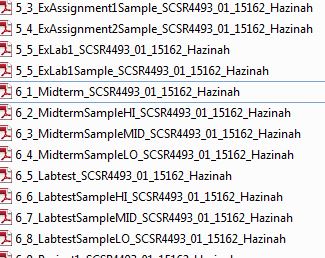Every semester we, at UTM, have to submit our course file for the courses we teach and manage on that particular semester. Surprisingly, even when we do this every semester, we still forget the content. I guess we are only human after all. So here I am putting down the list so you may refer and make your work easier.
There are 15 items in total that you need to have in your course file. These are the items in their ‘order of appearance‘ in the file.
- Appointment Letter for subject load of the particular semester. This letter will be furnished by the faculty (i.e. Deputy Dean Academic) by the first week of the semester.
- The Course Outline (or affectionately known as the L1). While this may be the same L1 used in previous semesters, please do specify the dates of each module taught within the course.
- Student List which can be obtained from the Aimsweb page. My advice download a new one, as the initial one may have changes of the students dropping the subject, registering late for whatever reason and some such.
- Copy of Teaching Material whether in any of these forms (.doc/.pdf/.ppt). my advice, pdf files are the best, as it can be opened anywhere. MSWord tend to have version restrictions.
- Coursework samples. This include Assignments, Tutorials, Labs, and anything else related to coursework. Attach sample of student’s works.
- Assessments throughout the semester like Quizzes, Midterm Exam or Tests (if you have more than one as opposed to a single midterm). Basically any and all assessments in ‘exam‘ form. Please include the question papers along with the answer scheme. Attach a ‘hi-lo-mid’ samples of students’ papers (that is the highest, average and lowest grades).
- Final Assessment. Include the final exam paper with its answer scheme. Also attach a ‘hi-lo-mid’ samples of students’ papers (that is the highest, average and lowest grades).
- Course work grades. These are ALL the coursework graded throughout the semester for that particular course. This is usually a sample of your Excel file. Please show clearly the maximum, average and minimum results for each category. If you have Homework, but it is not graded, no need to show those.
- The Final Grade Sheet and Statistical Report. After you submit the the marks to the central system (Aimsweb), you can print a statistical report and the grade sheet to put into your course file.
- Attendance list, proof of absence and record of consultation with problematic students. This means the total 14 weeks class attendance, along with records of absence of the students and their letters or medical certificates given as proof of absence. If you do a consultation either face-to-face or via e-communication, put it in here as well.
- A snapshot of e-learning/individual website for course management. Take a snapshot of your e-learning site and or website that you use to communicate with your class. In UTM, e-learning is heavily relied upon for communication, so use the snipping tool with flourish. **Note: If you are not sure what is the Snipping Tool, click here.
- Course survey questionnaires and results. If you do a survey in your class, upload the surveys and results here. With UTM e-learning, surveys are pretty easy to do. I’ll update a tutorial of it here soon.
- Other materials related to teaching. Upload any other materials, apart from No. 4 above in here. A video, a special tool, a special exercise, an excursion, class reviews, well you get the gist of it.
- Course coordinator report. This is only applicable if you have more than 1 sections with more than 1 lecturer (example: 6 sections, 4 lecturers). This report outlines coordination efforts, which include meetings, discussions and evaluation of lecturers.
- Course Review Report (CRR). The CRR is essentially the final review of your course, and whether or not it has ‘passed muster’, so to speak. In UTM, we upload all the student marks into the system and go through the flow to produce this report at the end. You have to present your reflection and plans to make the class and/or teaching better. This is a good way to assess your class, and for the next lecturer (or yourself) to enhance the course in the future.
There you have it folks. Last year (I believe) we were encouraged, in FC, to name each files within the course file as shown below. The numbers correspond to the list above and if you have more than one ‘product’ for the item, then you add the corresponding numbers accordingly.
Good luck. I shall await your visit back here next semester end. Cheerio!
















